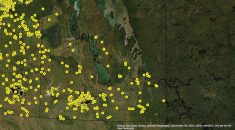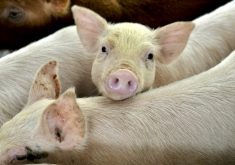Manitoba Pork is standing by the province’s proposed building code changes, even as advocacy group Hog Watch Manitoba argues they might increase the risk of hog barn fires.
In January 2017, Agriculture Minister Ralph Eichler announced plans to repeal the Farm Building Code and instead roll farm structures into the provincial building code.
The changes would create a “low-human occupancy” class, decrease firewall requirements in high-humidity environments where the building materials are likely to be be damaged and reduce “additional regulatory requirements for items like full fire alarm systems.”
Read Also

AgriStability enrolment deadline extended
The deadline for Manitoba farmers to enroll in the AgriStability business risk management program has been extended by three months agriculture minister Ron Kostyshyn announced on Friday.
“They do still have fire alarms,” Mike Teillet, Manitoba Pork manager of sustainable development, said. “They just have less fire alarms and smoke detectors.”
Changes were based on National Farm Building Code standards, he added. The previous Manitoba Farm Building Code, enacted in 2011, classified farm buildings as light or medium industrial occupancies.
- Read more: Hog Watch calls for safer barns
“The problem with that is that those assume a fairly high level of occupancy, of human occupancy, and that’s why the standards in the light industrial and commercial standards are different than they are in a farm building standard,” Teillet said. “You assume that there’s a lot of people working in a factory or whatever it is, so you need all sorts of exit doors all over the place and there’s a bunch of different things that are required. Barns have very low human occupation. In fact, most of the time there’s no one in a barn, so to have 10 fire exit doors is just pointless.”
The Manitoba Farm Building Code required that all areas of a barn be within 30 metres of an exit. Attics had to have fire stops every 300 metres and all new buildings or major renovations had to be signed off on by a structural engineer.
The new changes maintain the engineer assessment requirement, but roll back exit requirements, loosen stipulations on grouping buildings together and will allow doors to swing inwards, curbing the problem of livestock pushing them open.
“In the fire alarm portion of it, we asked producer groups and the response was that the moisture level in many of the farm buildings can cause operational issues with fire alarms. We believe that producers will take the proper preventive measures to protect their livestock,” Eichler said.
Stakeholders, including the Manitoba Pork Council, Keystone Agricultural Producers, the Office of the Fire Commissioner and insurance sector representatives, were consulted prior to the January announcement, he added.
At the time they were announced, the government estimated that changes would reduce the cost of a $2-million barn by about two to three per cent.
Those arguments, however, don’t hold water with Hog Watch Manitoba. The advocacy group is pushing for similar fire regulations in hog barns as in other public buildings.
“What they’re proposing is not going to help the situation of these barn fires,” Vicki Burns, of Hog Watch Manitoba, said. “It’s not strengthening any kind of fire prevention measures in the barns. I think it’s designed to allow it to be easier for people to construct hog barns rather that designed to minimize the likelihood of a fire such as the one that we just saw.”
Fire recently hit two feeder barns near New Bothwell, Man., June 8, killing an estimated 3,500 pigs. The cause of the fire is still under investigation.
It is the latest, but not only brush, Manitoba has had with hog barn fires. The province has a longer history with burning barns, including a spate of fires in 2008 which killed over 30,000 pigs and sparked a hard look at fire prevention and containment standards in the industry.
“It isn’t just the horrific way that pigs are dying. It must be terribly stressful for all the humans involved,” Burns said. “We understand that for the recent fire, the family is feeling quite devastated, and it must be very difficult also for all the firefighters that are called out. So really, preventing these barn fires, it seems to me there are multiple good reasons to do that.”
During 2008’s rash of fires, farm buildings were not covered in provincial building codes, although Teillet said most were inspected by an engineer and met separate standards set out by insurance companies. Manitoba Hydro also inspected barns before turning on power, Teillet said.
The 2008 fires eventually led to fire code regulations for new barns in 2009. In 2010, the Manitoba Farm Building Code was unveiled before being enacted the following year. The National Building Code was considered at that time, Teillet said, but the government of the day ultimately decided that the code was too outdated to easily upgrade.
The pork council has rejected the idea that the incoming changes might increase the risk of fire or the idea that more stringent fire codes may have prevented barn losses.
“Here’s the problem,” Teillet said. “There was no building code at all in place prior to 2011. We’ve built hardly any barns since 2011 and partially because of the moratorium, I might say. There’s a certain irony in that the people who are complaining about this — the fact is that the system would, over time, renew itself if we were allowed to build barns.”
Andrew Dickson, Manitoba Pork Council general manager, has identified barn replacement as one of his sector’s priorities going into 2018’s New Policy Framework, the successor to Growing Forward 2.
Dickson estimated that most of Manitoba’s barns are approaching 18-19 years old, close to the end of their 25-year lifespan.
The pork council has since been angling for more provincial help in planning barn replacement.
According to Teillet, bolstered ventilation guidelines under the new code may extend the life of barn electronics, while removing one of the most common causes of fire.
“Most fires are caused by electrical shorts or overheating in electrical boxes — that’s like switches, plugs, that sort of thing where wires connect,” he said. “What happens over time is they get moist from the moisture in the air and they get wet and they start to corrode and they can short out or overheat and that’s where most fires start in barns. By changing the air more often, it will keep the moisture levels down, and that should help to prevent fires.”
Manitoba pork expects between 50 and 100 barns to be built in the next five years, at least partially due to backlog after about a decade of moratoriums on barn building.
Burns and Hog Watch Manitoba are also looking to the incoming rush of hog barn construction. The group has argued that the market should better compensate pork producers to bring a higher fire prevention standard within their financial reach.
Burns also pointed to increasing pressure for hog barns to do away with gestational pens in lieu of group housing. The 2014 Code of Practice for the Care and Handling of Pigs from the National Farm Animal Care Council requires group housing for mated gilts and sows in new barns. By 2024, stalls will be allowed only if sows are given periodic freedom of movement.
“One of the reasons that we’re making these comments now is that we know that there’s going to be a lot of probably new barns constructed or retrofitting of barns, and if that’s going to happen, why not make these changes at the same time?” Burns said.
Hog Watch Manitoba met with the government in May to air some of its concerns, and plans to reach out again in light of the recent barn fire.
The group has not yet met with industry, although Burns said such a meeting might be beneficial.




















